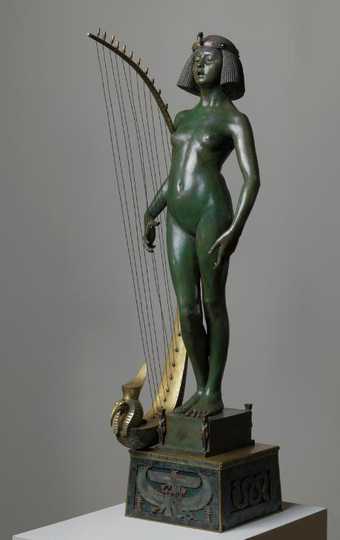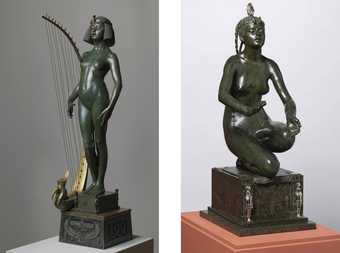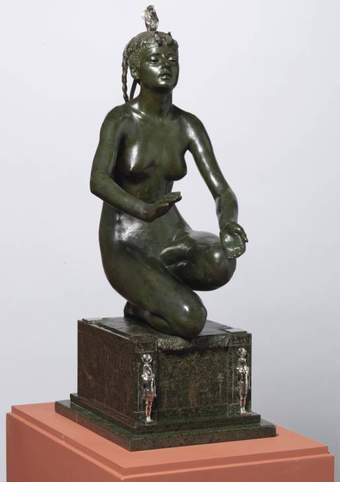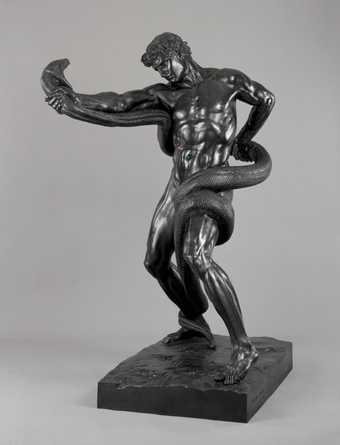How did you come to select these two sculptures for the In Focus project?
At the start of the project I worked my way through the Tate collection online, thinking about possible objects to write about. I had previously done quite a lot of research on the late Victorian sculptor Alfred Gilbert, in the context of some of his painterly and literary peers, and I was interested in developing my understanding of some of Gilbert’s more ambitious sculptural peers. My research on Gilbert had focused largely on the question of the possible meanings of the adolescent male body in the last decades of the nineteenth century, particularly in relation to the change in the age of consent in the mid-1880s, which was raised from thirteen to sixteen. As my research on Gilbert had been framed around larger questions of masculinity, I had not had time to explore these ideas in relation to the female body. When I saw the works by Ford in Tate’s collection, I realised that there was an exciting opportunity to do just that.
In addition, in the period after I had worked on Gilbert, I had been thinking quite hard about the character and contours of Victorian cosmopolitanism, particularly in relation to questions of empire, and the popular and scholarly British reception of archaeological sculpture from Egypt, Assyria and elsewhere. The dovetailing of these interests with my earlier interests in the adolescent body made Ford – and The Singer and Applause – an obvious choice.
What did you discover about the statuettes while working on the project?
Perhaps the most exciting thing I learned about the statuettes during the course of the project happened one afternoon when Neal Spencer, an Egyptologist from the British Museum, came to Tate Britain to look with me at the two Ford pieces. It was fascinating to look again at the pieces, by which time I knew quite well, through the eyes of a specialist in ancient Egyptian culture. Neal was able to confirm that the texts on the statuettes were, as reviews from the period suggested, translations of passages from the Harpist’s Song, a famous poem from the period that survived in various forms. Even more exciting, however, was the moment when Neal and I worked out that one of the other hieroglyphics represented a rendering of the sculptor’s name ‘a-i-w-n-s-l-aA f-i-a-r-d’. The text was followed by an image Neal did not recognise at first. Then we both realised that it depicted a sculptor at work on a standing statue. For more than a hundred years no one had written about the hieroglyphics, and here, in about fifteen minutes, Neal and I had cracked them.
The statuettes show Ford’s fascination with ancient Egyptian motifs. How unusual was this and how far should the works be seen in the context of Britain’s attitude towards Egypt and the Empire?
There was an enormous fascination in nineteenth-century Britain with all things ancient Egyptian, and with ancient Egyptian sculpture especially. And from the start, these interests were tied up with empire. For example, think of the way in which the arrival of the Egyptian statues at the British Museum was tied up with the context of the Napoleonic Wars, the way in which British curators and collectors vied with their French peers, for the spoils of Egypt, a territory which Napoleon kept a keen eye on. And think of the way in which, in somewhere like St Paul’s Cathedral, many of the Napoleonic monuments contain sphinxes and pyramids to signal that the commemorated heroes had played key roles in battles that had taken place in or around Egypt. Then think about something like the Albert Memorial, the way in which the Africa group differentiates Egypt, as a historical place of high culture, from the more primitivising figures from other places in Africa, the way in which Egypt is aligned with the classical world, the European world, and the circum-Mediterranean world. That said, while there are lots of marble Cleopatras, pyramids and sphinxes, Ford’s small-scale statuettes are pretty unique among sculptures made by his or indeed former generations, in terms of their visual complexity and the degree to which Ford had evidently sought out Egyptologists in the period to help him get details of text and iconography right.

Edward Onslow Ford
The Singer
(exhibited 1889)
Tate
In your project you explore Victorian attitudes to the adolescent female body. How should these affect our view of the sculptures today?
This is an interesting and a difficult question, since we live in a period in which the question of the adolescent female body is perhaps as vexed again for us as it was for the Victorians in the mid to late 1880s. With the raising of the age of consent from thirteen to sixteen, bodies of adolescent girls in their early teens, who formerly could have been imagined to be able to consent meaningfully to sex, suddenly became taboo, and a site of confusion, shame and anxiety. What did it mean that those bodies were now no longer presumed to be meaningfully able to consent? What did it mean that, previously, they were? What did it say about sculptors who employed models in their early teens? Patrons who bought objects depicting such figures? Viewers who saw them in shows? And critics who wrote about them? Could the Victorians, and can we, differentiate clearly the potential aesthetic appeal of a statuette depicting an adolescent girl in her early teens and the now taboo erotic appeal of the same girl if seen in the street? Ford’s work makes us think hard about such questions, about the ethics of viewing and making sculptures like these, and, indeed, of exhibiting them and writing about them. That said, I think these are good questions, necessary ones, and questions that are best addressed head on and carefully, not pushed under the carpet.
What did you most enjoy about studying Ford and his two statuettes at Tate?
For me, the best thing about studying Ford was the opportunity I had over a number of weeks to look closely at the objects, for literally hours at a time. In the period I was at Tate, the two Egyptian figures were on display, for the first time in a long period, and opposite to one another, for the first time in their entire exhibition history. It was a unique moment and a unique opportunity to reconsider the objects in detail and as a pair, and I found that they sustained my interest, and continued to pose interesting and difficult questions, minute by minute, hour by hour, and week by week. I hope that the writing that Neal and I did, in relation to these pieces, encourages other people to look at Ford’s work as closely, and to tease out new interpretations of them.



